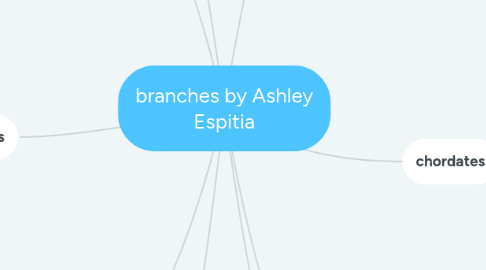
1. vertebrates
1.1. chordates that have a backbone
1.2. skeletal system and complex nervous system allow efficiency at two essential tasks
1.2.1. capturing food
1.2.2. evading predators
2. reptiles
2.1. reptile clade includes the tuataras, lizards, snakes, turtles, crocodilians, birds, and some extinct groups
2.2. have scales that create a waterproof barrier
2.3. Most lay shelled eggs on land
2.4. Most reptiles are ectothermic, absorbing external heat as the main source of body heat
2.4.1. Birds are endothermic, capable of maintaining body temperature through metabolism
2.5. Lepidosaurs
2.5.1. surviving lineage of lepidosaurs is represented by two species of lizard-like reptiles called tuataras
2.5.2. other major living lineage of lepidosaurs consists of the squamates, the lizards and snakes
2.5.2.1. Squamates are the most numerous and diverse reptiles, apart from birds
3. mammals
3.1. amniotes that have hair and produce milk
3.2. represented by more than 5,300 species
3.3. Mammals have:
3.3.1. Mammary glands, which produce milk
3.3.2. Hair
3.3.3. A high metabolic rate, due to endothermy
3.3.4. A larger brain than other vertebrates of equivalent size
3.3.5. Differentiated teeth
3.3.6. middle ear
3.4. Mammals are synapsids
3.4.1. Two bones that formerly made up the jaw joint > combined to form the mammalian middle ear
4. petromyzontida
4.1. A.K.A Lampreys
4.2. parasites that feed by clamping their mouth onto a live fish
4.3. inhabit various marine and freshwater habitats
4.4. have cartilaginous segments surrounding the notochord and arching partly over the nerve cord
5. tetrapods
5.1. gnathostomes ( jawed chordates) that have limbs
5.2. specific adaptations
5.2.1. Four limbs, and feet with digits
5.2.2. A neck, which allows separate movement of the head
5.2.3. Fusion of the pelvic girdle to the backbone
5.2.4. absence of gills
5.2.5. Ears for detecting airborne sounds
5.3. Tiktaalik
5.3.1. nicknamed fishapod
5.3.1.1. shows both fish and tetrapod characteristics
5.3.2. Fins, gills, lungs, and scales
5.3.3. Ribs to breathe air and support its body
5.3.4. A neck and shoulders
5.3.5. Fins with the bone pattern of a tetrapod limb
5.4. appeared 365 million years ago
6. echinodermata
6.1. sea star
6.2. slow-moving or sessile marine animals
6.3. unique water vascular system, a network of hydraulic canals branching into tube feet that function in locomotion and feeding
6.4. males and females are usually separate
6.5. sexual reproduction is external
6.6. Most adult echinoderms have radial symmetry
6.7. Living echinoderms are divided into five clades
6.7.1. Asteroidea (sea stars and sea daisies)
6.7.2. Ophiuroidea (brittle stars)
6.7.3. Echinoidea (sea urchins and sand dollars)
6.7.4. Crinoidea (sea lilies and feather stars)
6.7.5. Holothuroidea (sea cucumbers)
7. chordates
7.1. have a notochord and a dorsal, hollow nerve cord
7.2. consists of two basal groups of invertebrates as well as vertebrates
7.2.1. bilaterally symmetrical coelomates
7.2.2. segmented bodies
7.3. (phylum Chordata) are bilaterian animals that belong to the clade of animals known as Deuterostomia
7.4. Include all vertebrates & 2 groups of invertebrates, the urochordates and cephalochordates
7.5. 4 key characteristics
7.5.1. Notochord
7.5.1.1. a longitudinal, flexible rod between the digestive tube and nerve cord
7.5.1.1.1. provides structural support
7.5.2. Dorsal, hollow nerve cord
7.5.2.1. develops from a plate of ectoderm that rolls into a tube dorsal to the notochord
7.5.2.1.1. develops into the central nervous system: the brain and the spinal cord
7.5.3. Post-anal tail
7.5.3.1. Often reduced during embryonic development, Contains skeletal elements and muscles
7.5.3.1.1. provides propelling force
7.5.4. Pharyngeal slits or clefts
7.5.4.1. grooves in the pharynx called pharyngeal cleftsdevelop into slits that open to the outside of the body
8. amphibians
8.1. means “both ways of life”
8.2. represented by about 6,150 species in three clades
8.2.1. Urodela (salamanders)
8.2.2. Anura (frogs)
8.2.3. Apoda (caecilians)

